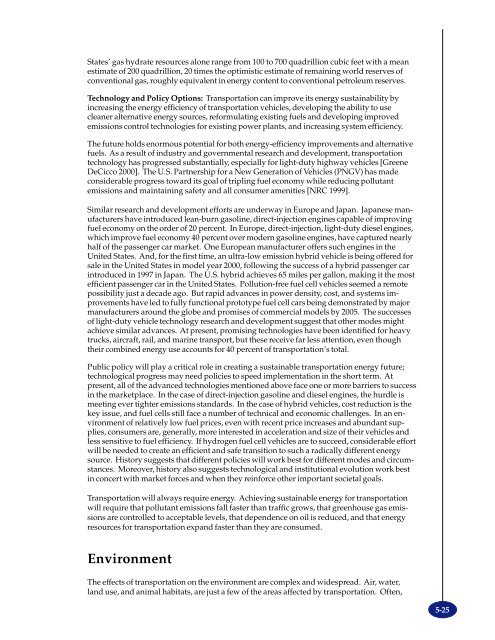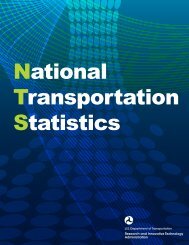TRANSPORTATION - BTS - Bureau of Transportation Statistics
TRANSPORTATION - BTS - Bureau of Transportation Statistics
TRANSPORTATION - BTS - Bureau of Transportation Statistics
Create successful ePaper yourself
Turn your PDF publications into a flip-book with our unique Google optimized e-Paper software.
States’ gas hydrate resources alone range from 100 to 700 quadrillion cubic feet with a meanestimate <strong>of</strong> 200 quadrillion, 20 times the optimistic estimate <strong>of</strong> remaining world reserves <strong>of</strong>conventional gas, roughly equivalent in energy content to conventional petroleum reserves.Technology and Policy Options: <strong>Transportation</strong> can improve its energy sustainability byincreasing the energy efficiency <strong>of</strong> transportation vehicles, developing the ability to usecleaner alternative energy sources, reformulating existing fuels and developing improvedemissions control technologies for existing power plants, and increasing system efficiency.The future holds enormous potential for both energy-efficiency improvements and alternativefuels. As a result <strong>of</strong> industry and governmental research and development, transportationtechnology has progressed substantially, especially for light-duty highway vehicles [GreeneDeCicco 2000]. The U.S. Partnership for a New Generation <strong>of</strong> Vehicles (PNGV) has madeconsiderable progress toward its goal <strong>of</strong> tripling fuel economy while reducing pollutantemissions and maintaining safety and all consumer amenities [NRC 1999].Similar research and development efforts are underway in Europe and Japan. Japanese manufacturershave introduced lean-burn gasoline, direct-injection engines capable <strong>of</strong> improvingfuel economy on the order <strong>of</strong> 20 percent. In Europe, direct-injection, light-duty diesel engines,which improve fuel economy 40 percent over modern gasoline engines, have captured nearlyhalf <strong>of</strong> the passenger car market. One European manufacturer <strong>of</strong>fers such engines in theUnited States. And, for the first time, an ultra-low emission hybrid vehicle is being <strong>of</strong>fered forsale in the United States in model year 2000, following the success <strong>of</strong> a hybrid passenger carintroduced in 1997 in Japan. The U.S. hybrid achieves 65 miles per gallon, making it the mostefficient passenger car in the United States. Pollution-free fuel cell vehicles seemed a remotepossibility just a decade ago. But rapid advances in power density, cost, and systems improvementshave led to fully functional prototype fuel cell cars being demonstrated by majormanufacturers around the globe and promises <strong>of</strong> commercial models by 2005. The successes<strong>of</strong> light-duty vehicle technology research and development suggest that other modes mightachieve similar advances. At present, promising technologies have been identified for heavytrucks, aircraft, rail, and marine transport, but these receive far less attention, even thoughtheir combined energy use accounts for 40 percent <strong>of</strong> transportation’s total.Public policy will play a critical role in creating a sustainable transportation energy future;technological progress may need policies to speed implementation in the short term. Atpresent, all <strong>of</strong> the advanced technologies mentioned above face one or more barriers to successin the marketplace. In the case <strong>of</strong> direct-injection gasoline and diesel engines, the hurdle ismeeting ever tighter emissions standards. In the case <strong>of</strong> hybrid vehicles, cost reduction is thekey issue, and fuel cells still face a number <strong>of</strong> technical and economic challenges. In an environment<strong>of</strong> relatively low fuel prices, even with recent price increases and abundant supplies,consumers are, generally, more interested in acceleration and size <strong>of</strong> their vehicles andless sensitive to fuel efficiency. If hydrogen fuel cell vehicles are to succeed, considerable effortwill be needed to create an efficient and safe transition to such a radically different energysource. History suggests that different policies will work best for different modes and circumstances.Moreover, history also suggests technological and institutional evolution work bestin concert with market forces and when they reinforce other important societal goals.<strong>Transportation</strong> will always require energy. Achieving sustainable energy for transportationwill require that pollutant emissions fall faster than traffic grows, that greenhouse gas emissionsare controlled to acceptable levels, that dependence on oil is reduced, and that energyresources for transportation expand faster than they are consumed.EnvironmentThe effects <strong>of</strong> transportation on the environment are complex and widespread. Air, water,land use, and animal habitats, are just a few <strong>of</strong> the areas affected by transportation. Often,5-25
















